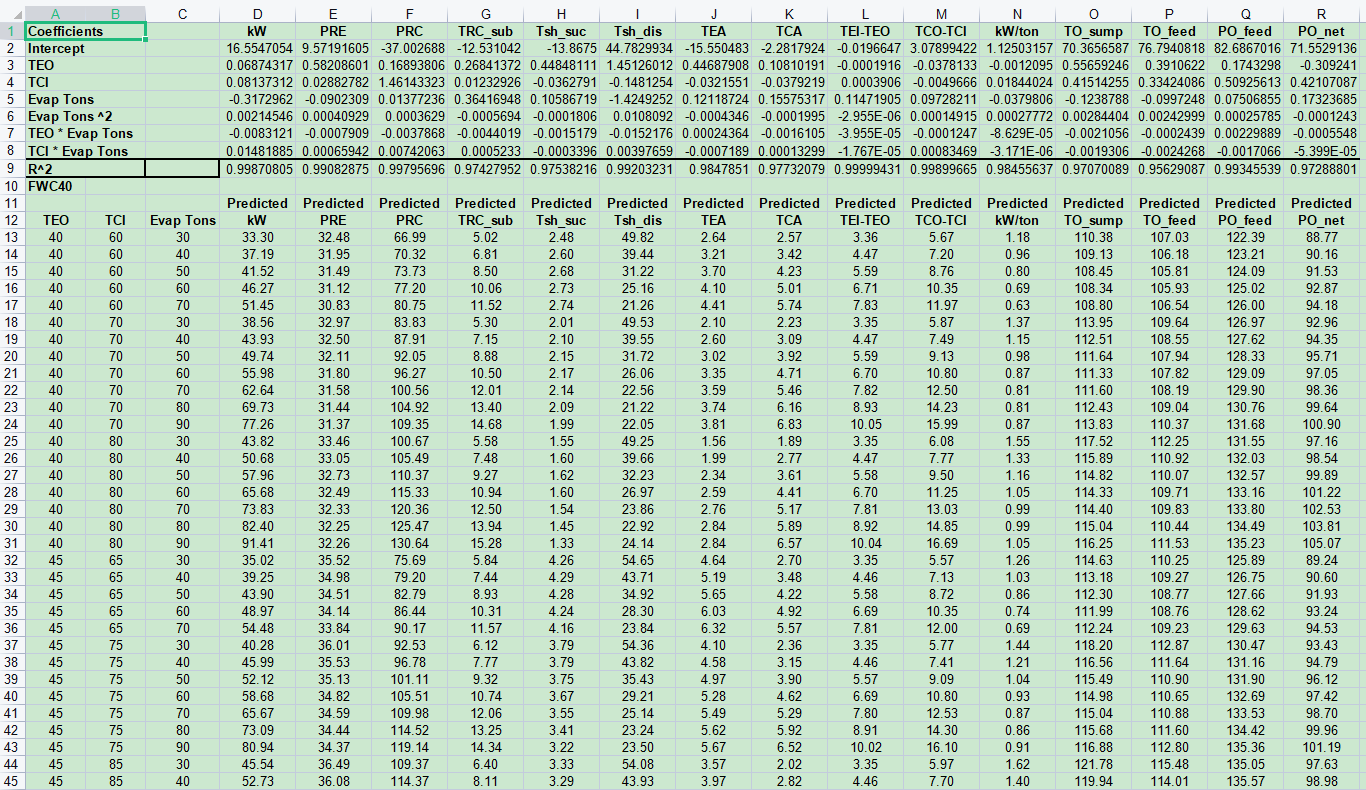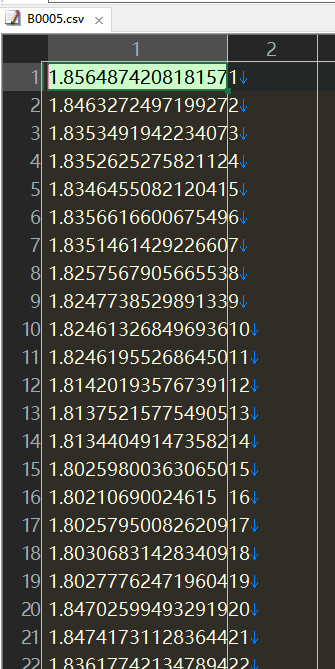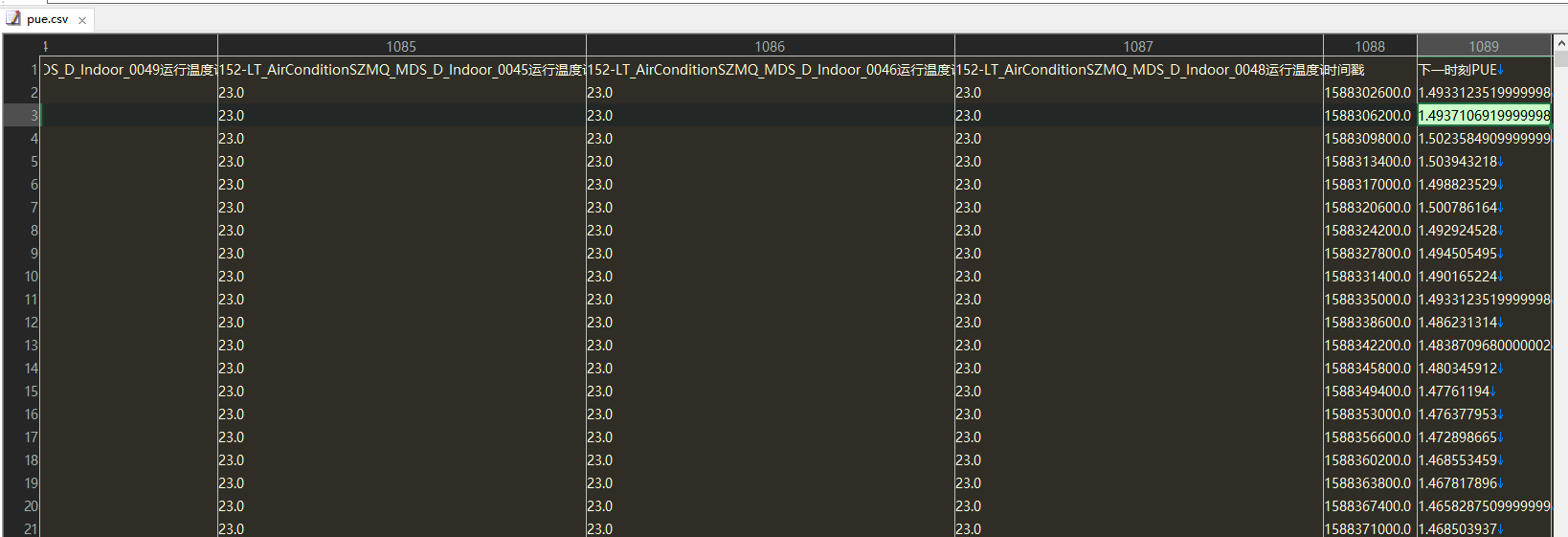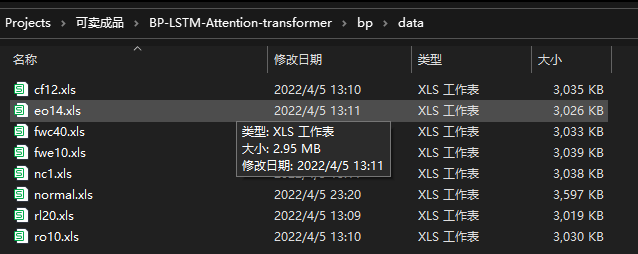BP-LSTM-Attention-transformer,含数据,可直接运行,TensorFlow
1、摘要
本文主要讲解:BP-LSTM-Attention-transformer,含数据,可直接运行,TensorFlow
主要思路:
- 使用bp神经网络做多分类
- 使用cnn-lstm-attention做时间序列预测
- 使用transformer做时间序列预测
2、数据介绍
bp的数据有八个类别,每个类别里有不同的特征的数据

lstm+attention的数据是时间序列数据,蓄电池按时间的寿命数据

transformer数据是温度值跟pue的关系

3、文件介绍





4、完整代码和步骤
此代码的依赖环境如下:
tensorflow==2.5.0
keras==2.6.0
numpy==1.19.5
matplotlib==3.5.2
torch==1.8.0
opencv-python==4.2.0.32
pandas==1.1.5
scikit-learn==0.22.1
代码输出如下:
主运行程序入口
import math
import os
import time
import csv
import numpy as np
import pandas as pd
import torch
import torch.nn as nn
import matplotlib.pyplot as plt
from sklearn import metrics
from sklearn import preprocessing # 导入库
from sklearn.feature_selection import SelectKBest, f_regression
from sklearn.metrics import mean_squared_error
from sklearn.model_selection import train_test_split
from sklearn.preprocessing import MinMaxScaler
from torch.autograd import Variable
# os.chdir(r'D:\项目\transformer-pue\实验')
def writeOneCsv(relate_record, src):
with open(src, 'a', newline='\n') as csvFile:
writer = csv.writer(csvFile)
writer.writerow(relate_record)
def min_max_select(X_train, y_train, head_feature_num):
scaler = MinMaxScaler(feature_range=(0, 1))
all_data = pd.DataFrame(scaler.fit_transform(X_train), columns=X_train.columns)
scaled = pd.DataFrame(preprocessing.scale(all_data), columns=all_data.columns)
X_train = scaled.loc[0:len(X_train) - 1]
# 特征选择
X_scored = SelectKBest(score_func=f_regression, k='all').fit(X_train, y_train)
feature_scoring = pd.DataFrame({
'feature': X_train.columns,
'score': X_scored.scores_
})
feat_scored = feature_scoring.sort_values('score', ascending=False).head(head_feature_num)['feature']
writeOneCsv([head_feature_num, feat_scored.values.tolist()], '选择后的特征.csv')
X_train = X_train[X_train.columns[X_train.columns.isin(feat_scored)]]
return X_train.values, y_train.values
class PositionalEncoding(nn.Module):
def __init__(self, d_model, max_len=5000):
super(PositionalEncoding, self).__init__()
pe = torch.zeros(max_len, d_model)
position = torch.arange(0, max_len, dtype=torch.float).unsqueeze(1)
div_term = torch.exp(torch.arange(0, d_model, 2).float() * (-math.log(10000.0) / d_model))
pe[:, 0::2] = torch.sin(position * div_term)
pe[:, 1::2] = torch.cos(position * div_term)
pe = pe.unsqueeze(0).transpose(0, 1)
self.register_buffer('pe', pe)
def forward(self, x):
return x + self.pe[:x.size(0), :]
class TransAm(nn.Module):
def __init__(self, feature_size=250, num_layers=1, dropout=0.1):
super(TransAm, self).__init__()
self.model_type = 'Transformer'
self.src_mask = None
self.pos_encoder = PositionalEncoding(feature_size)
self.encoder_layer = nn.TransformerEncoderLayer(d_model=feature_size, nhead=2, dropout=dropout)
self.transformer_encoder = nn.TransformerEncoder(self.encoder_layer, num_layers=num_layers)
self.decoder = nn.Linear(2 * feature_size, 1)
self.init_weights()
self.feature_size = feature_size
self.num_layers = num_layers
self.dropout = dropout
def feature(self):
return {"feature_size": self.feature_size, "num_layers": self.num_layers, "dropout": self.dropout}
def init_weights(self):
initrange = 0.1
self.decoder.bias.data.zero_()
self.decoder.weight.data.uniform_(-initrange, initrange)
def forward(self, src):
if self.src_mask is None or self.src_mask.size(0) != len(src):
device = src.device
mask = self._generate_square_subsequent_mask(len(src)).to(device)
self.src_mask = mask
src = self.pos_encoder(src)
output = self.transformer_encoder(src, self.src_mask)
output = output.view(output.shape[0], -1)
output = self.decoder(output)
return output
def _generate_square_subsequent_mask(self, sz):
mask = (torch.triu(torch.ones(sz, sz)) == 1).transpose(0, 1)
mask = mask.float().masked_fill(mask == 0, float('-inf')).masked_fill(mask == 1, float(0.0))
return mask
class General_Regression_Training_3d():
def reg_calculate(self, true, prediction):
'''
To calculate the result of regression,
including mse, rmse, mae, r2, four criterions.
'''
prediction[prediction < 0] = 0
mse = mean_squared_error(true, prediction)
mae = metrics.mean_absolute_error(true, prediction)
return mse, mae
def __init__(self, net, learning_rate=[1e-3, 1e-5, 1e-7], batch_size=1024, epoch=2000, use_more_gpu=False,
weight_decay=1e-8, device=0, save_path='CNN_Result'):
self.net = net
self.resultDict = {"learning_rate": learning_rate, "batch_size": batch_size, "epoch": epoch,
"weight_decay": weight_decay, "use_more_gpu": use_more_gpu, "device": device, }
self.resultDict = dict(self.resultDict, **self.net.feature())
self.batch_size = batch_size
self.use_more_gpu = use_more_gpu
self.lr = learning_rate
self.epoch = epoch
self.weight_decay = weight_decay
self.device = device
self.epoch = epoch
self.save_path = save_path # 设置一条保存路径,直接把所有的值都收藏起来
if not os.path.exists(self.save_path):
os.makedirs(self.save_path)
self.avgLossList = [] # put the avgLoss data
self.TrainLosses = []
self.TestLosses = []
self.t = 0
self.D = []
self.n = 0 # 来记录 梯度衰减 的次数
self.limit = [1e-5, 1e-6, 1e-7]
def create_batch_size(self, X_train, y_train):
p = np.random.permutation(X_train.shape[0])
data = X_train[p]
label = y_train[p]
batch_size = self.batch_size
batch_len = X_train.shape[0] // batch_size + 1
b_datas = []
b_labels = []
for i in range(batch_len):
try:
batch_data = data[batch_size * i: batch_size * (i + 1)]
batch_label = label[batch_size * i: batch_size * (i + 1)]
except:
batch_data = data[batch_size * i: -1]
batch_label = label[batch_size * i: -1]
b_datas.append(batch_data)
b_labels.append(batch_label)
return b_datas, b_labels
def fit(self, X_train, y_train, X_test, y_test):
''' training the network '''
# input the dataset and transform into dataLoad
# if y is a scalar
if y_train.ndim == 1:
y_train = y_train.reshape(-1, 1)
if y_test.ndim == 1:
y_test = y_test.reshape(-1, 1)
self.X_train, self.X_test, self.y_train, self.y_test = X_train, X_test, y_train, y_test
b_data, b_labels = self.create_batch_size(X_train, y_train)
save_result = os.path.join(self.save_path, 'Results.csv')
try:
count = len(open(save_result, 'rU').readlines())
except:
count = 1
net_weight = os.path.join(self.save_path, 'Weight')
if not os.path.exists(net_weight):
os.makedirs(net_weight)
net_path = os.path.join(net_weight, str(count) + '.pkl')
net_para_path = os.path.join(net_weight, str(count) + '_parameters.pkl')
# set the net use cpu or gpu
device = torch.device(self.device if torch.cuda.is_available() else "cpu")
if torch.cuda.is_available():
print("Let's use GPU: {}".format(self.device))
else:
print("Let's use CPU")
if self.use_more_gpu and torch.cuda.device_count() > 1:
print("Let's use", torch.cuda.device_count(), "GPUs")
self.net = nn.DataParallel(self.net)
self.net.to(device)
# network change to train model
self.net.train()
# set optimizer and loss function
try:
optim = torch.optim.Adam(self.net.parameters(), lr=self.lr[0], weight_decay=self.weight_decay)
except:
optim = torch.optim.Adam(self.net.parameters(), lr=self.lr, weight_decay=self.weight_decay)
criterion = torch.nn.MSELoss()
# Officially start training
start = time.time() # 计算时间
limit = self.limit[0]
for e in range(self.epoch):
tempLoss = []
self.net.train()
for i in range(len(b_data)):
if torch.cuda.is_available():
train_x = Variable(torch.FloatTensor(b_data[i])).to(device)
train_y = Variable(torch.FloatTensor(b_labels[i])).to(device)
else:
train_x = Variable(torch.FloatTensor(b_data[i]))
train_y = Variable(torch.FloatTensor(b_labels[i]))
prediction = self.net(train_x)
loss = criterion(prediction, train_y)
tempLoss.append(float(loss))
optim.zero_grad()
loss.backward()
optim.step()
self.D.append(loss.cpu().data.numpy())
avgloss = np.array(tempLoss).sum() / len(tempLoss)
self.avgLossList.append(avgloss)
if ((e + 1) % 100 == 0):
print('Training... epoch: {}, loss: {}'.format((e + 1), self.avgLossList[-1]))
self.net.eval()
if torch.cuda.is_available():
test_x = Variable(torch.FloatTensor(self.X_test)).to(device)
test_y = Variable(torch.FloatTensor(self.y_test)).to(device)
else:
test_x = Variable(torch.FloatTensor(self.X_test))
test_y = Variable(torch.FloatTensor(self.y_test))
test_prediction = self.net(test_x)
test_loss = criterion(test_prediction, test_y)
self.TrainLosses.append(avgloss)
self.TestLosses.append(test_loss.cpu().data.numpy())
self.test_prediction = test_prediction.cpu().data.numpy()
self.test_prediction[self.test_prediction < 0] = 0
# epoch 终止装置
if len(self.D) >= 20:
loss1 = np.mean(np.array(self.D[-20:-10]))
loss2 = np.mean(np.array(self.D[-10:]))
d = np.float(np.abs(loss2 - loss1)) # 計算loss的差值
if d < limit or e == self.epoch - 1 or e > (self.epoch - 1) / 3 * (
self.n + 1): # 加入遍历完都没达成limit限定,就直接得到结果
self.D = [] # 重置
self.n += 1
print('The error changes within {}'.format(limit))
self.e = e + 1
print(
'Training... epoch: {}, loss: {}'.format((e + 1), loss.cpu().data.numpy()))
torch.save(self.net, net_path)
torch.save(self.net.state_dict(), net_para_path)
self.net.eval()
if torch.cuda.is_available():
test_x = Variable(torch.FloatTensor(self.X_test)).to(device)
test_y = Variable(torch.FloatTensor(self.y_test)).to(device)
else:
test_x = Variable(torch.FloatTensor(self.X_test))
test_y = Variable(torch.FloatTensor(self.y_test))
test_prediction = self.net(test_x)
test_loss = criterion(test_prediction, test_y)
self.test_prediction = test_prediction.cpu().data.numpy()
self.test_prediction[self.test_prediction < 0] = 0
plt.figure(figsize=(10, 10))
plt.plot(test_prediction.tolist(), color="red")
plt.plot(test_y.tolist(), color="green")
plt.title('real vs pred test')
plt.ylabel('pue')
plt.xlabel('x')
plt.legend(['pred', 'real'], loc='lower right')
plt.savefig("real_pred_" + str(feature_selection_ratio) + '.png', dpi=500, bbox_inches='tight')
plt.show()
self.mse, self.mae = self.reg_calculate(self.y_test, self.test_prediction)
print('\033[1;35m Testing epoch: {}, loss: {} , mae: {} \033[0m!'.format((e + 1),
test_loss.cpu().data.numpy(),
self.mae))
# 已经梯度衰减了 2 次
if self.n == 2:
print('The meaning of the loop is not big, stop!!')
break
limit = self.limit[self.n]
print('Now learning rate is : {}'.format(self.lr[self.n]))
optim.param_groups[0]["lr"] = self.lr[self.n]
mse_list.append(test_loss.cpu().data.numpy())
end = time.time()
self.t = end - start
print('Training completed!!! Time consuming: {}'.format(str(self.t)))
mse_list = []
ratio_list = []
for i in range(1, 11):
pue = pd.read_csv('pue.csv', encoding='gbk')
pue.dropna(axis=0, how='all')
pue.fillna(0, inplace=True)
train = pue.drop(['下一时刻PUE', '时间戳'], axis=1)
target = pue['下一时刻PUE']
print('feature_selection_ratio')
feature_selection_ratio = i / 10
print(feature_selection_ratio)
ratio_list.append(feature_selection_ratio)
head_feature_num = int(feature_selection_ratio * train.shape[1])
train, target = min_max_select(train, target, head_feature_num)
# 切割数据样本集合测试集
X_train, x_test, y_train, y_true = train_test_split(train, target, test_size=0.2) # 20%测试集;80%训练集
X_train_Double = []
for line in X_train:
tempList = []
for l in line:
tempList.extend([l, l])
X_train_Double.append([np.array(tempList), np.array(tempList)])
X_train_Double = np.array(X_train_Double)
X_test_Double = []
for line in x_test:
tempList = []
for l in line:
tempList.extend([l, l])
X_test_Double.append([np.array(tempList), np.array(tempList)])
X_test_Double = np.array(X_test_Double)
print("X_train_Double.shape:", X_train_Double.shape, "X_test_Double.shape:", X_test_Double.shape)
feature_size = X_train_Double.shape[2]
model = TransAm(feature_size=feature_size, num_layers=1, dropout=0.2)
grt = General_Regression_Training_3d(model, learning_rate=[1e-3, 1e-6, 1e-8], batch_size=512, use_more_gpu=False,
weight_decay=1e-3, device=0, save_path='transformer_Result', epoch=5000)
grt.fit(X_train_Double, y_train, X_test_Double, y_true)
plt.figure(1)
plt.plot(ratio_list, mse_list, 'r-.p', label="mse")
plt.xlabel("feature_selection_ratio")
plt.ylabel("mse")
plt.savefig('feature_selection_ratio_mse.png')
plt.show()
所有完整代码和数据请移步:
BP-LSTM-Attention-transformer,含数据,可直接运行,TensorFlow